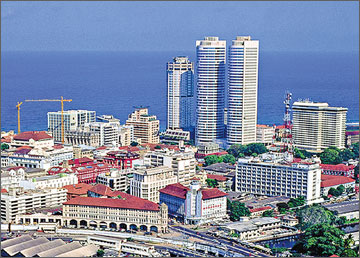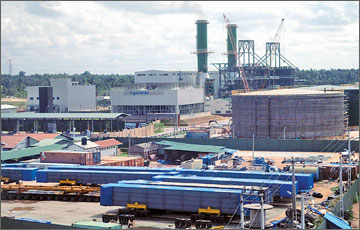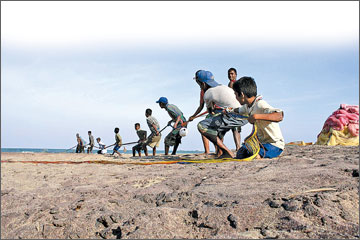Sound policies drive economy forward
*First quarter growth at 7 percent:
*Progress in all sub-sectors:
*Agriculture, industry and services lead
growth:
By Uditha KUMARASINGHE
|

President Mahinda Rajapaksa at a vap magul ceremony. Much progress
has been made in agriculture sector.
|
The economy posted a significant growth of seven percent in the first
quarter of 2010, supported by resilient domestic demand and the gradual
recovery in the global economic conditions owing to the sound economic
policies adopted by the Government.
The robust growth had been exhibited in all sub-sectors with
agriculture, industry and services sectors recording growth rates of
nine percent, 6.9 percent and 6.7 percent. The economy grew by 6.2
percent in the last quarter of 2009 and it is expected that the economy
will grow at a faster pace of about seven-eight percent in 2010 with
favourable macro-economic environment and political stability with the
cessation of the internal conflict.
According to the Mid-Year Fiscal Management Report 2010 of the
Ministry of Finance and Planning, agriculture, forestry and fishing
sectors expanded at an accelerated pace of nine percent during the first
quarter of 2010 from 3.6 percent in the same quarter of 2009. This
sector contributed 14 percent of the GDP in the first quarter of 2010.
This upturn came largely from the relatively significant performance of
tea, rubber and minor export crops.
The tea sector registered a 47.2 percent growth for the first quarter
of 2010 compared to 39.7 percent in the review period of 2009,
reflecting the expansion of export demand coupled with favourable
weather conditions during the first quarter of 2010. Tea production
during the January to April period was 102.3 million Kg, an increase of
27 percent over the corresponding period of 2009. The average tea prices
at the Colombo Tea Auction recorded the highest ever price at Rs.379.20
per Kg in March 2010 compared to Rs.325.34 per Kg in March 2009.
The rubber sector also benefited from attractive prices with
increasing demand for natural rubber due to a gradual increase in oil
prices and adoption of new technologies. Contracted rubber production in
the first quarter of 2009 picked up in the first four months of 2010 and
recorded a growth of 10 percent. Production increased to 54.3 million Kg
in the first four months of 2010 from 49.3 million Kg in the same period
of 2009. Value added rubber production grew by 11.7 percent in the first
quarter of 2010 as compared to 2.6 percent recorded in the review period
of 2009. The average prices of rubber at the Colombo Auction rose to
Rs.321.24 per Kg in the first quarter of 2010 from Rs.132.17 per Kg in
the corresponding period of 2009, indicating a 143 percent growth in
prices in the first quarter of 2010. Coconut oil production increased by
31 percent in the first quarter of 2010 to 21,667 mt, benefiting from
the increased tax rates on imported coconut oil substitutes.

Colombo, the financial hub |

Work under way at a power plant |

Fisheries sector recorded growth during the period |
Paddy production in 2009/2010 Maha season increased by nine percent
to around 2.6 million mt compared to the 2008/2009 Maha season, the
highest ever paddy production since 1952, benefiting from increased land
for cultivation, increased average yield by four percent supported by
favourable weather conditions during the period and continuation of the
fertiliser subsidy. The total extent harvested had also increased by
almost five percent over the 2009/2010 Maha season. It is also
noteworthy that the paddy production in the Eastern Province, Mannar and
Jaffna districts had recorded significant growths of 10.6 percent, 65.1
percent and 13.8 percent. Meanwhile, minor export agricultural crops
comprising cinnamon, cardamom, cloves and pepper recorded the highest
ever growth of 118 percent during the reviewed quarter from the
contracted 5.3 percent growth of the first quarter of 2009. Most
subsidiary food crops such as highland crops, fruits and vegetables
recorded a favourable growth of 5.5 percent during this period. The
production of maize, big onions, red onions and potatoes had recorded an
encouraging growth of nine percent, 23 percent, 59 percent and eight
percent.
Transport and communication
The transport and communication sector accelerated by 10.4 percent in
the reference period of 2010 compared to 3.9 percent in the same period
of 2009. The posts and telecommunication sector recorded a buoyant
growth of 16.4 percent in the quarter particularly with the continuation
of services expanded by the telecom service providers in terms of value
added products, competitive rates and the expansion of coverage.
Reflecting the expansion of activities in the global market, export
earnings registered a 7.1 percent growth in the first quarter of 2010.
Export earnings for the review period were US$ 1,764 million against the
US$ 1,647 million in the same period of 2009. Agricultural and mineral
exports grew at a pace of 29 percent and 33 percent.
The import sector also performed well in the first quarter of 2010,
making a 39.5 percent growth compared to the sluggish growth of 1.7
percent in the same quarter of 2009. The domestic trade sector also
expanded at a pace of 8.3 percent in the first quarter of 2010 from 3.8
percent recorded in the review period of 2009.
In the industry sector, value addition expanded by 6.9 percent in the
first quarter of 2010 compared to a mere 1.9 percent growth recorded in
the same period of 2009. This growth was achieved with favourable
contributions from all sectors, namely manufacturing, mining and
quarrying, construction, electricity, gas and water. The industry sector
accounted for 28.4 percent of GDP. Despite declining external demand and
the high cost of production, the textiles, apparel and leather products
sector showed one percent growth in the first quarter of 2010. The
service sector expanded by 6.7 percent during the first quarter of 2010
compared to one percent in the same period of 2009.
This sector accounted for 57.7 percent of the GDP and was mainly
driven by the recovery in wholesale and retail trade, hotels and
restaurants, tourism sector services and transport services.
Port services expanded in the review period of 2010 with cargo and
container handling increasing by 40 percent and 27 percent, benefiting
from the strong performance in the trade sector aligned with a gradual
recovery of the global economy. The number of new vehicle registrations
also increased by 56.5 percent in the first quarter of 2010 compared to
the negative growth of 30.5 percent recorded in the reference period of
2009.
The hotels and restaurant sector responded quickly to the cessation
of terrorist activities coupled with the gradual recovery of the global
economic conditions and recorded a buoyant growth of 61 percent in the
first quarter of 2010 compared to 16.7 percent growth in the first
quarter of 2009.
Tourist arrivals increased to 160,409 in the first quarter of 2010
from 106,702 in the same period of 2009, reflecting a 50 percent growth
while earnings from tourism related activities and room occupancy rates
climbed by 70 percent and 89 percent. Earnings from the tourism sector
in the period between January and April 2010 was US$ 175 million.
Construction industry
The construction industry sustained its growth momentum at 8.5
percent in the first quarter of 2010 in comparison to equally high
growth rates witnessed in 2006 and 2007.
The growth rate registered for the first quarter of 2009 was at three
percent. This is attributable to Government initiatives taken to improve
infrastructure mainly in roads, irrigation, ports, power, water,
resumption of private sector initiatives on urban property development
projects coupled with a low interest rate regime that prevailed during
this period.
The performance of the banking, insurance and real estate sector
picked up in the first quarter of 2010, registering a growth of 5.6
percent with improved economic conditions.
Commercial banks and Licensed Specialised banks showed a high profit
due to the increased non-interest income and introduced cost-management
policies amidst declining interest income.
The food, beverages and tobacco products sector registered a higher
growth of 6.8 percent with enhanced production of biscuits, canned
fruits and vegetables, ice cream, milk and coconut-based products
benefiting from the improved connectivity of the whole country, coupled
with the expansion of tourist activities.
The sector will be revived during the second half of 2010 with
further expansion of domestic markets, improved value added products,
modernisation of dairy factories and establishment of milk collection
and sales centres. The factory industry grew by 5.4 percent in the first
quarter of 2010 compared to 3.3 percent registered in the same period of
2009.
The factory industry recovered gradually since the latter part of
2009 with the revival of external demand and an increase in domestic
demand due to access of new markets in Northern and Eastern regions.
Livestock production increased by five percent, particularly with an
increase in dairy production responding to the higher prices.
During the first quarter of 2010, local milk production reached 48.9
million litres, a 15 percent growth over the corresponding period of
2009, benefiting from favourable producer prices and other incentives
given to the sector by the Government to boost local milk production.
The fisheries sub-sector recorded a four percent growth in the first
quarter of 2010 with a rise in marine and inland fish production by four
percent and one percent owing to the decision taken by the Government to
lift the restrictions on fishing activities in the North and the East.
|

